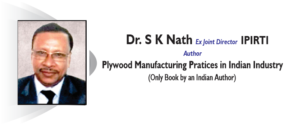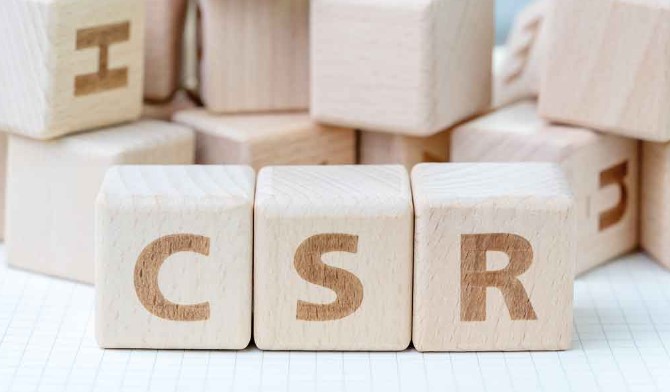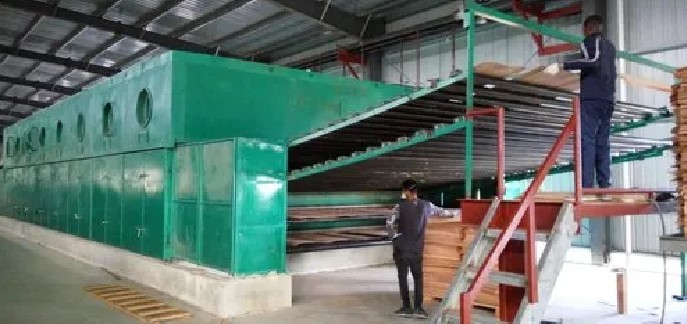
Moisture Content in Veneer & Timber before Hot Pressing
- February 13, 2023
- 0
Why drying of veneer, block board and flush door filler to particular moisture content is necessary?
What are the effects of over/under drying of veneer/wood while making multilayer panel?
Drying is a process in which moisture in wood is removed in the form of water vapour by application of heat or at normal air temperature. The purpose of drying veneer is to reduce its moisture content to a range suitable for gluing and making panels. The word ‘suitable’ moisture content in wood is indicative in the sense that wood/veneer should not be at zero moisture content nor at moisture content higher than ‘suitable’ to attain good bonding while making panel.
Does it mean two wood surfaces cannot be bonded with adhesive if moisture content in wood is zero? No, two wood surfaces can be bonded with adhesive when there is no moisture in wood. But it is necessary to understand why certain amount of moisture has to be present in wood while making multilayer panel by curing the resin polymer at elevated temperature.
In making of plywood, assembly of veneer is pressed between two hot platens under pressure. During the period of hot pressing following things happen:
i) Under pressure pieces of veneers in the assembly are held in places with surfaces one layer in close proximity to the surface of the adjoining layer;
ii) Part of the glue from glued veneer penetrate to non-glued (Panel) veneer and major quantity of glue gets spread between two layers of veneer in the assembly;
iii) Resin in the glue mix gets cured into rigid mass, fix the veneers in the assembly in respective places and hold veneer rigidly to form a sheet product.
Role of moisture: i) During assembly of veneer, glue is applied on glue core and then glue core and panel core are arranged in alternate layer. Under pressure when the glue core surface and panel core surface come in close contact, dry panel core will suck moisture from more wet glue core and in this process a part of the glue will also move into porous panel veneer and deposit in the pores of panel core. As the resin in the glue mix cures during hot pressing, the glue in the pores get cured along with that in the glue line to form tentacles which remains rigidly attached to the glue line between two layers of veneer.
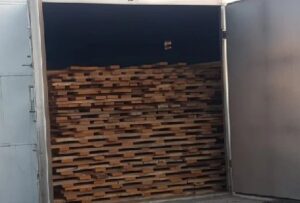
If moisture content in veneer is zero then it will suck more moisture from glue along with resin (which is water soluble) leaving very small quantity of glue in the glue line. This will lead to poor bond between veneers of opposite layers. On the other hand, higher moisture in veneer will lead to formation of blister and/or steam pocket in plywood as the total steam formed during hot pressing will not get time to escape during scheduled period of hot pressing.
ii) In making plywood, glue is cured by application of heat. During hot pressing heat is applied on the two surface layers of the assembly by the hot platen of the hot press. Wood is non-conductor of heat, and hence, veneer cannot transfer heat from surface to inner layers in a multiply plywood assembly. It is the moisture in the veneer and glue which form steam and transfer heat from surface to inner layer of glue line.
In the case of 18mm or 19mm plywood it takes about 3 to 4.5 minutes for the inside glue line to reach 800C at which temperature the resin starts to show its first change in chemical sense. It will be semi fluid provided it is still in moist condition. If the glue is too dry due to over dry veneer, hot veneer, long assembly time or thin spread, an incomplete flow of glue will take place, leading to poor bond. High moisture content will cause more penetration, washing out of glue to the edges from glue line or formation of blows.
iii) In the case of manufacture of block board and flush door with wooden strips at the central layer, the role of moisture is applicable as said above. But if seasoning of wooden planks is not properly done, the surface of planks shows required moisture content but at the interior of the plank the level of moisture remains higher. While making block board and flush door with such wood, moisture from interior of wooden strips will come out as vapour and obstruct curing of resin during schedule period of hot pressing and also get deposited wherever there is gap in whole assembly. Panel products made with wooden strips made from improperly seasoned timber will show delamination and blister in product.
Before discharging the wooden planks from seasoning kiln by detecting the surface moisture of the planks is not adequate, but the sample plank should be cross cut and moisture content at the centre of the cross cut area should be tested. If the moisture content at the interior of the plank is higher than that at surface, further seasoning is necessary after steaming inside the seasoning chamber and seasoning be continued till moisture content reaches desired value throughout the entire plank.
In wood panel manufacturing in India for hot pressing, the following moisture conditions have been found to suit good:
- Face veneer- 6-10%,
- Core and panel with amino resin – 6-8%,
- Core and panel with phenolic resin – around 6%,
- Block board and flush door filler – max. 10%,
- Glue line moisture content before hot pressing after pre pressing >12% and <20%.
(Values given are as per experience and thumbs rule and should not be taken as absolute).
हाॅट प्रेसिंग से पहले
विनियर और लकड़ी में नमी की मात्रा
आवश्यक नमी की मात्रा के लिए विनियर, ब्लॉक बोर्ड और फ्लश डोर फिलर को सुखाना क्यों आवश्यक है?
बहुपरत पैनल बनाते समय विनियर/लकड़ी के अधिक/कम सुखाने के क्या प्रभाव होते हैं?
सुखाना एक ऐसी प्रक्रिया है जिसमें लकड़ी में मौजूद नमी को गर्म करके या सामान्य हवा के तापमान पर जल भाप के रूप में हटा दिया जाता है। विनियर को सुखाने का उद्देश्य इसकी नमी की मात्रा को ग्लूइंग और पैनल बनाने के लिए उपयुक्त सीमा तक कम करना है। लकड़ी में ’उपयुक्त’ नमी की मात्रा इस अर्थ में सांकेतिक है कि पैनल बनाते समय अच्छी बॅन्डिंग प्राप्त करने के लिए लकड़ी/विनियर में शून्य नमी की मात्रा नहीं होनी चाहिए और न ही नमी की मात्रा ’उपयुक्त’ से अधिक होनी चाहिए।
क्या इसका मतलब यह है कि लकड़ी में नमी की मात्रा शून्य होने पर लकड़ी की दो सतहों को चिपकने से नहीं जोड़ा जा सकता है? नहीं, लकड़ी में नमी न होने पर दो लकड़ी की सतहों को चिपकने से जोड़ा जा सकता है। लेकिन यह समझना जरूरी है कि ऊंचे तापमान पर रेजिन पॉलीमर को क्योर करके मल्टीलेयर पैनल बनाते समय लकड़ी में एक निश्चित मात्रा में नमी क्यों मौजूद होनी चाहिए।
प्लाईवुड बनाने में विनियर की असेंबली (परतों) को दबाव में दो गर्म प्लेटों के बीच दबाया जाता है। हॉट प्रेसिंग की अवधि के दौरान निम्नलिखित चीजें होती हैंः
i) असेम्बली में विनियर के टुकड़ों को उन जगहों पर रखा जाता है जहां सतहों की एक परत दुसरी की परत की सतह के करीब होती हैं;
ii) ग्लू विनियर से ग्लू का हिस्सा गैर-ग्लू (पेनल) विनियर में प्रवेश करता है और असेंबली में विनियर की दो परतों के बीच ग्लू की बड़ी मात्रा फैल जाती है;
iii) ग्लू मिश्रण में रेजीन कठोर द्रव्यमान में स्थिर हो जाता है, विनियर को असेंबली में संबंधित स्थानों पर ठीक करता है और शीट उत्पाद बनाने के लिए विनियर को मजबूती से पकड़ लेता हैं।
नमी की भूमिकाः i) विनियर की असेंबली के दौरान, ग्लू कोर पर ग्लू लगाया जाता है और फिर ग्लू कोर और पैनल कोर को वैकल्पिक परत में व्यवस्थित किया जाता है। दबाव में जब ग्लू कोर सतह और पैनल कोर सतह निकट संपर्क में आती है, तो शुष्क पैनल कोर अधिक गीले ग्लू कोर से नमी सोख लेगा और इस प्रक्रिया में ग्लू का एक हिस्सा झरझरा पैनल विनियर में चला जाएगा और पैनल के छिद्रों में जमा हो जाएगा। चूंकि ग्लू मिश्रण में रेजीन हाॅट प्रेंसिग के दौरान स्थिर हो जाता है, उसके साथ साथ ग्लू लाइन का ग्लू भी छिद्रों में स्थिर होते हुए जाल बना देता है जो दोनो परतों के बीच ग्लू लाइन में कठोरता से बना रहता है।
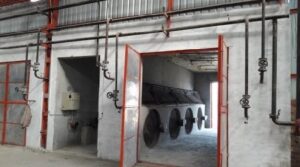
अगर विनियर में नमी की मात्रा शून्य है तो यह रेजीन (जो पानी में घुलनशील है) के साथ ग्लू से अधिक नमी सोख लेगी और ग्लू लाइन में बहुत कम मात्रा में ग्लू बच जाएगा। इससे विपरीत परतों के विनियर के बीच खराब बंधन होगा। दूसरी ओर, विनियर में अधिक नमी से प्लाइवुड में ब्लिस्टर और/या स्टीम पॉकेट का निर्माण होगा क्योंकि हॉट प्रेसिंग के दौरान बनने वाली कुल भाप को हॉट प्रेसिंग की निर्धारित अवधि के दौरान बाहर निकलने का समय नहीं मिलेगा।
ii) प्लाइवुड बनाने में ग्लू को गर्म करके पकाया जाता है। हाॅट प्रेंसिग के दौरान गर्म प्रेस के गर्म प्लेटन द्वारा एकत्रित कोर की दो सतह परतों पर गर्मी दी जाती है। लकड़ी गर्मी की कुचालक होती है, और इसलिए, विनियर मल्टीप्ल प्लाईवुड असेंबली में सतह से भीतरी परतों तक गर्मी स्थानांतरित नहीं कर सकता है। यह विनियर और ग्लू की नमी है जो भाप बनाती है और सतह से गर्मी को ग्लू लाइन की आंतरिक परत में स्थानांतरित करती है। 18 मिमी या 19 मिमी प्लाईवुड के मामले में अंदर की ग्लू लाइन को 80ण् तक पहुंचने में लगभग 3 से 4.5 मिनट लगते हैं, जिस तापमान पर ग्लू रासायनिक अर्थों में अपना पहला परिवर्तन दिखाना शुरू करता है।
यह अर्ध द्रव होगा जब तक यह नम स्थिति में हो। यदि अत्यधिक शुष्क विनियर, हॉट विनियर, लंबे असेम्बली समय या पतले फैलाव के कारण ग्लू बहुत अधिक शुष्क हो जाता है, तो ग्लू का प्रवाह अधूरा होगा, जिससे बंधन खराब होगा। उच्च नमी की मात्रा ग्लू लाइन में ग्लू की किनारों से बाहर होने सा बुलबुलो के गठन के कारण अधिक पैठ का कारण बनेगी।
iii) केंद्रीय परत में लकड़ी की पट्टियों के साथ ब्लॉक बोर्ड और फ्लश डोर के निर्माण के मामले में, ऊपर बताए अनुसार नमी की भूमिका लागू होती है। लेकिन अगर लकड़ी के तख्तों की सीज़निंग ठीक से नहीं की जाती है, तो तख्तों की उपरी सतह में आवश्यक नमी की मात्रा दिखाई देती है, लेकिन तख़्त के अंदरूनी हिस्से में नमी का स्तर अधिक रहता है। ऐसी लकड़ी से ब्लॉक बोर्ड और फ्लश डोर बनाते समय लकड़ी की पट्टियों के अंदर की नमी वाष्प के रूप में बाहर आ जाएगी और हाॅट प्रेसिंग की निर्धारित अवधि के दौरान रेजिन को पकाने में बाधा उत्पन्न करेगी और पूरी असेंबली में जहां कहीं भी गैप होगा वहां ही जमा हो जाएगी। अपूर्ण तरीके से सीजन की हुई लकड़ी से बनी लकड़ी की पट्टियों से बने पैनल उत्पाद में डीलेमीनेसन और फफोले हो जाएंगे।
लकड़ी के तख़्तों को सीज़निंग कक्ष से निकालने से पहले तख़्तों की सिर्फ उपरी सतह की नमी का पता लगाना पर्याप्त नहीं है, लेकिन नमूना तख़्ता को क्रॉस कट करना चाहिए और क्रॉस कट क्षेत्र के केंद्र में नमी की मात्रा का परीक्षण किया जाना चाहिए। यदि तख़्ते के भीतरी हिस्से में नमी की मात्रा उपरी सतह की तुलना में अधिक है, तो सीज़निंग कक्ष के अंदर फिर से भाप देकर और सीज़निंग आवश्यक है और सीज़निंग को तब तक जारी रखा जाना चाहिए जब तक कि पूरे तख़्त में नमी की मात्रा वांछित मूल्य तक न पहुँच जाए।
भारत में वुड पैनल निर्माण में हॉट प्रेसिंग के लिए निम्नलिखित नमी की स्थिति को संतुलित पाया गया हैः
- फेस विनियर- 6-10ः
- कोर और पैनल अमीनो रेजिन के साथ- 6-8ः,
- कोर और पैनल फेनोलिक रेजिन के साथ- लगभग 6ः,
- ब्लॉक बोर्ड और फ्लश डोर फिलर- अधिकतम 10ः,
- ग्लू लाइन नमी प्री प्रेंसिग के बाद और हाॅट प्रेंसिग से पहले 12 प्रतिशत से अधिक और 20 प्रतिशत से कम
(दिए गए मान अनुभव और क्रमित आधारभूत नियम के अनुसार हैं और इसे पूर्ण नहीं माना जाना चाहिए)।
